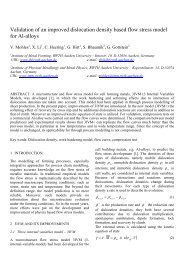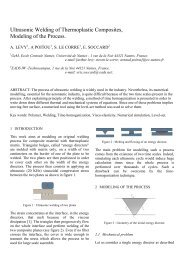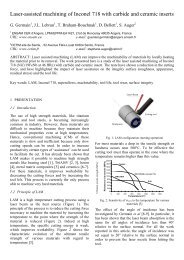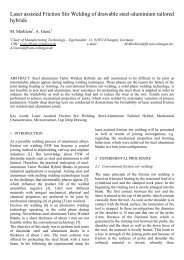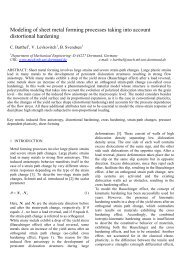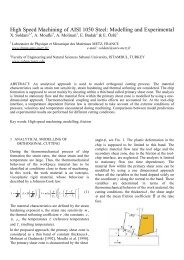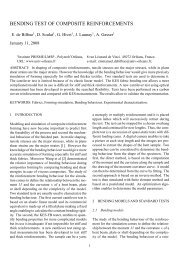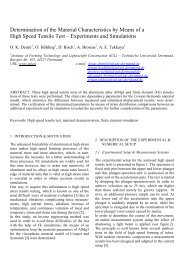o<strong>the</strong>r hand, it has not been observed in o<strong>the</strong>rs [2].The second assumption is also plausible, but <strong>the</strong>literature also presents examples where wear waspredominantly dictated by ploughing, ra<strong>the</strong>r than bygalling [14]. In terms of <strong>the</strong> comparisons provi<strong>de</strong>dby <strong>the</strong> crossed cylin<strong>de</strong>r test, Podgornik [7] observedthat uncoated tools performed better than toolscoated with titanium nitri<strong>de</strong> (TiN). Based on <strong>the</strong>results of <strong>the</strong> industrial operations analysed in thiswork, it is difficult to imagine that this result wouldoccur in industry. Therefore, in addition to <strong>the</strong>validity of <strong>the</strong> assumptions presented above, it ispossible to suppose that some of <strong>the</strong> conditionsimposed during <strong>the</strong> line or point contact tests areunable to entirely reproduce <strong>the</strong> conditions found inpractice. One of <strong>the</strong> possible explanations for <strong>the</strong>sedifferences is <strong>the</strong> nominal contact pressure, which,in <strong>the</strong>se tests, tends to be larger than in <strong>the</strong> industrialconditions [9]. A reduction in pressure would bepossible in <strong>the</strong> crossed cylin<strong>de</strong>r test, but, in this case,<strong>the</strong> sliding distance would probably have to besignificantly increased until <strong>de</strong>tectable wear wouldbe noticed. As a result, repetition of <strong>the</strong> regions incontact would possibly occur during each test cycle;a condition that is frequently not observed informing operations [12].Finally, it is possible to expect that tests that involveactual sliding of strips against <strong>the</strong> surface of toolswould provi<strong>de</strong> results in good agreement with thoseobserved in industrial operations. However, <strong>the</strong>setests frequently <strong>de</strong>mand specially <strong>de</strong>signe<strong>de</strong>quipment and may require large and complexshaped specimens.4 CONCLUSIONSThe literature presents a large number of laboratorytests <strong>de</strong>dicated to <strong>the</strong> study of <strong>the</strong> wear phenomenonknown as galling and/or <strong>the</strong> tribology in formingoperations as a whole. A qualitative comparison ofsome of <strong>the</strong>se tests with results obtained directly inindustrial operations indicate that, in spite of <strong>the</strong>large number, most of <strong>the</strong> options are still notentirely satisfactory. Apparently, none of <strong>the</strong>m isable to provi<strong>de</strong> a simple means to analyse factorssuch as contact pressure, lubrication, continuous orintermittent contact, refreshment of contact area, inor<strong>de</strong>r to not only analyse galling, but also, ifnecessary, conduct <strong>the</strong> test with different levels ofpredominance of galling over o<strong>the</strong>r phenomena.ACKNOWLEDGEMENTSThe authors acknowledge two Brazilian founding agencies forfinancial support: <strong>the</strong> São Paulo State Research Foundation -FAPESP through projects number 2006/02006-2 and2003/10157-2 and The National Council for Scientific andTechnological Development (CNPq) through project550235/03-5.REFERENCES1. ASTM G40, Standard Terminology Relating to Wearand Erosion, ASTM International, West Conshohocken(2005).2. K.G. Budinski, M.K. Budinski and M.S. Kohler, Agalling-resistant substitute for silicon nickel, Wear 255(2003) 489-97.3. ASTM G98, Standard Test Method for GallingResistance of Materials, ASTM International, WestConshohocken (2002).4. S.R. Hummel, Development of a galling resistance testmethod with a uniform stress distribution, Tribol. Int. 41(<strong>2008</strong>) 175-80.5. S.R. Hummel and B. Partlow, Comparison of thresholdgalling results from two testing methods, Tribol. Int. 37(2004) 291-5.6. K. Gurumoorthy, M. Kamaraj, K. Prasad Rao and S.Venugopal, Development and use of combined weartesting equipment for evaluating galling and high stresssliding wear behaviour, Mater. Des. 28 (2007) 987-92.7. B. Podgornik, S. Hogmark and J. Pezdirnik, Comparisonbetween different test methods for evaluation of gallingproperties of surface engineered tool surfaces, Wear 257(2004) 843-51.8. S.R. Hummel, New test method and apparatus formeasuring galling resistance, Tribol. Int. 34 (2001)593-7.9. P.A. Swanson, L.K. Ives, E.P. Whitenton and M.B.Peterson, A study of <strong>the</strong> galling of two steels using twotest methods, Wear 122 (1988) 207-23.10. L.M. Bernick, R.R. Hilsen and C.L. Wandrei,Development of quantitative sheet galling test, Wear 48(1978) 323-46.11. M. Hanson, N. Stavlid, E. Coronel and S. Hogmark, Onadhesion and metal transfer in sliding contact betweenTiN and austenitic stainless steel, Wear in press.12. E. Schedin, Galling mechanisms in sheet formingoperations, Wear 179 (1994) 123-8.13. F. Clarysse, W. Lauwerens and M. Vermeulen,Tribological properties of PVD tool coatings in formingoperations of steel sheet, Wear 264 (<strong>2008</strong>) 400-4.14. C. Boher, D. Attaf, L. Penazzi and C. Levaillant, Wearbehaviour on <strong>the</strong> radius portion of a die in <strong>de</strong>ep-drawing:I<strong>de</strong>ntification, localisation and evolution of <strong>the</strong> surfacedamage, Wear 259 (2005) 1097-108.15. M. Hirasaka and H. Nishimura, Effects of <strong>the</strong> surfacemicro-geometry of steel sheets on galling behavior, J.Mater. Process. Technol. 47 (1994) 153-66.16. J.L. Andreasen, N. Bay and L. <strong>de</strong> Chiffre, Quantificationof galling in sheet metal forming by surface topographycharacterization, Int. J. Mach. Tool Manu., 38 (1998)503-10.
DFT – Mo<strong>de</strong>ling of <strong>the</strong> Reaction of a Polysulfur Extreme-PressureLubricant Additive on Iron SurfaceB. Monasse, P. MontmitonnetEcole <strong>de</strong>s Mines <strong>de</strong> Paris PARISTECH, CEMEF, UMR 7635, BP 207, 06904 Sophia-Antipolis Ce<strong>de</strong>x, FranceURL: www-cemef.cma.fr e-mail: bernard.monasse@ensmp.fr e-mail: pierre.montmitonnet@ensmp.frABSTRACT: sulfur-containing molecules are used as extreme pressure additive for low-alloy steel surfaces.These molecules react with ferrous surfaces and form FeS x compounds which strength <strong>the</strong> surface and reducescuffing. The stable conformation and <strong>the</strong> chemical stability and reactivity of an alkyl sulfur molecule(DTDP) with oxygen and an iron surface are here predicted by DFT mo<strong>de</strong>l. The effect of <strong>the</strong> conformation of<strong>the</strong> molecule respective to <strong>the</strong> surface acts on <strong>the</strong> surface reactivity.Key words: polysulfur, iron, reactivity, semi-empirical functional,1 INTRODUCTIONSulfur-containing organic molecules have been usedfor a long time as extreme pressure additives inlubricating oils. Several papers report oncomparisons of <strong>the</strong> tribological efficiency of organosulfuradditives as a function of number of sulfuratoms, alkyl- or aryl-chains [1]. In tribotests,involving ferrous materials and S-containingadditives, <strong>the</strong> formation of <strong>the</strong> FeS x compound hasbeen <strong>de</strong>tected in superficial layers by differentsurface analysis techniques [2, 3]. FeS, also knownas troilite, has a layered hexagonal structure, lowshear strength and high melting point (1100 °C), soit is an effective solid lubricant like graphite andMoS 2 [4]. HSAB <strong>the</strong>ory may also shed light on thosespecies which react to form <strong>the</strong>se layers [5]. Themolecule may be <strong>the</strong>rmally <strong>de</strong>composed or oxidizedin <strong>the</strong> lubricant during rolling process or reacts on<strong>the</strong> metallic surface. The <strong>de</strong>tails of <strong>the</strong> reaction pathare never<strong>the</strong>less poorly known, and so is <strong>the</strong> effectof <strong>the</strong> environment (dissolved oxygen, temperature,…) on preferred reaction paths and reactivity andwill be analyzed in <strong>the</strong> present work.Quantum mo<strong>de</strong>ls have been applied to study <strong>the</strong>reactivity of some sulfur molecules on variousmetallic surfaces [6]. Most of <strong>the</strong> papers are focusedon copper, palladium and nickel for catalyticpurpose with simple sulfur molecules. Reactions acton <strong>the</strong> first layers of metal mainly for gas phasereactions [6,7]. The sulfur may be randomlydistributed on copper surface or organized asmobile sulfur metal clusters Cu 3 S 3 [8]. Theorganisation of metal sulfur molecules may <strong>de</strong>pendon <strong>the</strong> reaction path of <strong>the</strong> sulfur during its reactionwith metal surface. We consi<strong>de</strong>r here <strong>the</strong> reaction ofa di-tertio-do<strong>de</strong>cyl-pentasulfur molecule (C 12 H 25 S 5C 12 H 25 , DTDP) with a bcc iron [001] surface.2 SIMULATIONThe simulations have been done with a semiempiricalmo<strong>de</strong>l MOPAC using <strong>the</strong> functional PM5.The results were confirmed by simulations witho<strong>the</strong>r semi-empirical functionals AM1 and PM3 anda DFT functional B88-LYP. The MOPAC softwareis coupled to <strong>the</strong> graphical user interface CAChe.Full geometry optimization of a standalone moleculeis searched first to <strong>de</strong>fine <strong>the</strong> equilibriumconformation of <strong>the</strong> molecule. This conformation issearched from various initial non-equilibrated state.A molecular dynamics simulation allows us tofollow <strong>the</strong> conformational change around <strong>the</strong>equilibrium conformation. The stable conformation



